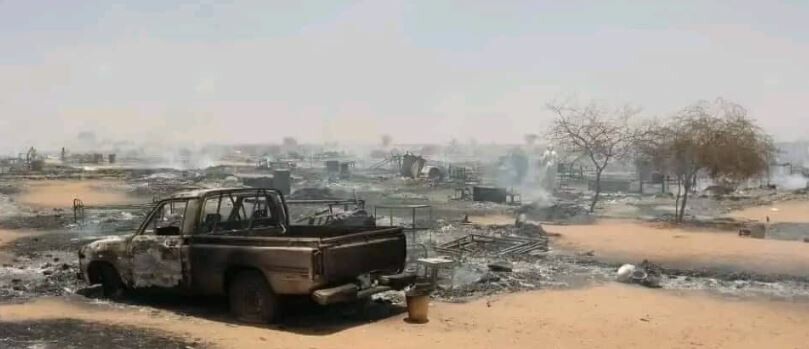There has recently been widespread apprehension about the evolving fighting between the Rapid Support Forces (RSF) and the Sudanese Armed Forces (SAF), along with the respective armed movements allied to them, taking on an ethnic dimension in Al-Fasher, the capital of Sudan’s North Darfur State.
Eissa Dafa-Allah, a journalist specializing in Darfur affairs, expressed his concerns in an interview with Radio Tamazuj and said the conflict might take an ethnic direction.
“This ongoing conflict may morph into an ethnic one between the two tribes comprising the conflicting parties following the burning of villages west of Al-Fasher, most of which are inhabited by the Zaghawa tribe, leading to numerous violations and an expansion of the circle of new victims,” he stated.
Dafa-Allah urged the warring parties to cease hostilities and refrain from the wanton killing of innocent civilians, and the displacement of citizens from their homes. He called upon the belligerents to stop depriving people of necessities, respect international humanitarian law, uphold the rights of civilians, and protect them during armed confrontations.
On her part, Miriam Musa, a resident of Al-Fasher, reported that the RSF and their allied militias attacked and burned down the village of Shagra and other surrounding villages, displacing their inhabitants.
Shagra is predominantly inhabited by the Zaghawa tribe, representing the power center of the Darfur region, and is from where Minni Arko Minniwa, the leader of the Sudan Liberation Movement (SLM) hails.
“Joint forces from the armed movement and the Army have countered them, halting the violations and inflicting losses without any actual statistics available on the losses suffered by both sides,” Musa stated.
She also said that a large Zaghawa force entered the Malit area of Al-Fasher to aid the fighting groups and rescue and protect the remaining villages.
Meanwhile, Ahmed Hussein, the director of the armed movement’s media office, corroborated Musa’s statement on Thursday and told this publication that the RSF had been rampaging for over a week now.
“The indiscriminate attacks carried out by the RSF and their allied militias in Western Al-Fasher for over a week now are driven by retaliatory motives, reminiscent of what happened in 2003 in the Darfur region and its various villages,” he stated.
Hussein anticipates that the conflict will take on ethnic dimensions between the Zaghawa and Arab tribes rather than continue as a war between the RSF and SAF.
He said his group would respond firmly and forcefully to any situation.
However, a local activist in Al-Fasher who spoke on condition of anonymity told this publication that the current conflict is not tribal-based in his assessment, but described the attack by the RSF as reckless. He justified this by citing the significant numbers and the presence of battalions and leadership of Zaghawa tribesmen within the RSF ranks.
“I hope that these concerns will remain mere speculation and not materialize as it would plunge Al-Fasher and its inhabitants into a very dark and perilous tunnel,” he said.
The battles between the RSF and the SAF, along with their allied armed groups, have continued since last week, alongside aerial bombardment by military aircraft on the cities of Al-Fasher and Kutum.
Al-Fasher has witnessed the torching of villages in the eastern and western parts, leading to the displacement of its residents.
In a UN report released on Tuesday, the Humanitarian Research Lab at the Yale School of Public Health confirmed that at least nine villages were destroyed in Western Al-Fasher due to deliberate fires between 31 March and 15 April.
The report relied on remote sensing data analysis and satellite imagery, cross-referenced with open-source information. It affirmed the findings of various media outlets and other open-source reports indicating that these villages were attacked by the RSF during this timeframe.
Furthermore, the report stated that each village showed visible thermal signs consistent with deliberate burning during the reported attack period. Five of the nine confirmed locations showed positive indicators of the thermal infrared imaging radiometry group, indicating fire occurrence during the reported attack period. The distance of these locations ranged from 25 km to 40 km from Al-Fasher.




